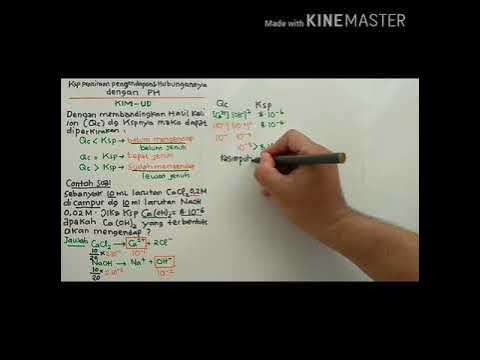Kelarutan dan Hasil Kali Kelarutan : Memprediksi Terbentuknya Endapan
Summary
TLDRThis video explains how to predict precipitation based on solubility product (Ksp) data. It introduces the concept of solubility and its relation to ion concentrations in solution, demonstrating how to use Ksp values to determine whether a precipitate will form. By comparing the ion product (Qc) to the Ksp, three scenarios are outlined: no precipitation (under-saturated), precipitation (supersaturated), or equilibrium (saturated). The video also includes examples to solidify understanding, using common salts like AgCl, Na2CO3, and others, while highlighting the importance of concentration and ion interactions in predicting precipitation.
Takeaways
- 😀 Understanding solubility and solubility product (Ksp) is essential for predicting precipitation reactions.
- 😀 The ion concentration of salts, such as AgCl, can be used to determine if precipitation will occur.
- 😀 Three possible scenarios exist when mixing solutions containing ions: no precipitation, exact saturation, or precipitation.
- 😀 If the product of the ion concentrations (QC) is less than Ksp, no precipitation will occur, as the solution is unsaturated.
- 😀 If QC equals Ksp, the solution is at exact saturation, and no precipitation occurs unless conditions change.
- 😀 If QC is greater than Ksp, the solution is supersaturated, and precipitation will occur.
- 😀 The concept of QC can be applied to any insoluble salt to predict whether precipitation will occur based on ion concentrations.
- 😀 To predict the formation of a precipitate, we compare QC with Ksp values, where QC > Ksp leads to precipitation.
- 😀 For each salt in the examples (Ag2S, Ag3PO4, Ag2SO4, etc.), the QC values are calculated by multiplying the concentrations of the involved ions.
- 😀 Comparing the calculated QC to the Ksp values determines whether a precipitate will form, helping in identifying the salts that will precipitate from the solutions.
Q & A
What is the concept of solubility product (Ksp) discussed in the video?
-The solubility product (Ksp) is a constant that represents the product of the concentrations of ions in a saturated solution of a slightly soluble salt. It helps predict whether a precipitate will form when two solutions containing the ions of an insoluble salt are mixed.
How does pH affect the solubility of salts according to the video?
-The pH of a solution can affect the solubility of salts by altering the concentration of ions in solution. A lower pH (more acidic) can increase solubility by shifting equilibria, while a higher pH (more basic) may decrease solubility by precipitating certain ions out of solution.
What happens when the ion product (Qc) is less than the Ksp value?
-When the ion product (Qc) is less than the Ksp value, the solution is unsaturated, and no precipitation occurs. The solution can still dissolve more solute until it reaches saturation.
What does it mean when Qc is equal to Ksp?
-When Qc is equal to Ksp, the solution is exactly saturated, and the system is in equilibrium. No further dissolution or precipitation occurs.
What does it mean when Qc is greater than Ksp?
-When Qc is greater than Ksp, the solution is supersaturated, and precipitation will occur as the system tries to reach equilibrium by forming a solid.
Can you explain the concept of precipitation using the example of AgCl in the video?
-In the video, AgCl is a sparingly soluble salt. When two solutions containing Ag+ and Cl- ions are mixed, the outcome depends on the ion concentrations. If the product of the ion concentrations (Qc) exceeds the Ksp value, AgCl will precipitate out of the solution.
In the example with Na2CO3 and AgNO3, how do you determine if a precipitate will form?
-To determine if a precipitate will form, calculate the ion concentrations for Ag+ and CO3^2-. Then, find the ion product (Qc) by multiplying the concentrations raised to the power of their respective coefficients. Compare Qc with the Ksp value; if Qc exceeds Ksp, a precipitate forms.
How is the ion concentration affected when solutions are mixed in the second example involving AgNO3?
-When solutions are mixed, the volume doubles, which halves the concentration of each ion. This dilution affects the ion product (Qc), and it must be recalculated to determine if precipitation occurs based on the new concentrations.
What did the video conclude about the formation of precipitates for various salts like Ag2S, Ag3PO4, Ag2CrO4, AgBr, and Ag2SO4?
-The video demonstrated that each salt's precipitation depends on the ion product (Qc) and the Ksp value. If Qc is greater than Ksp, precipitation occurs; if Qc is less than Ksp, no precipitation happens. Various salts like Ag2S, Ag3PO4, and AgBr formed precipitates, while Ag2CrO4 and Ag2SO4 did not.
What is the key takeaway from the video regarding predicting precipitation in solutions?
-The key takeaway is that by calculating the ion product (Qc) and comparing it to the Ksp value, you can predict whether a precipitate will form. If Qc exceeds Ksp, precipitation occurs; if it is less than Ksp, no precipitation will form.
Outlines

This section is available to paid users only. Please upgrade to access this part.
Upgrade NowMindmap

This section is available to paid users only. Please upgrade to access this part.
Upgrade NowKeywords

This section is available to paid users only. Please upgrade to access this part.
Upgrade NowHighlights

This section is available to paid users only. Please upgrade to access this part.
Upgrade NowTranscripts

This section is available to paid users only. Please upgrade to access this part.
Upgrade Now5.0 / 5 (0 votes)





